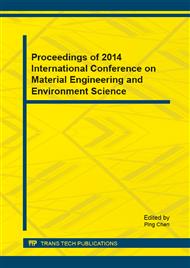[1]
Y.F. Wei, Z. Zhong, Z.Y. Gu, Z, Qiu, C.B. Zhang, F.C. Sun, Chemical oxidation treatment for semi volatile organic compounds contaminated brownfield site: a case study, Advanced Materials Research 414(2012), 317-322.
DOI: 10.4028/www.scientific.net/amr.414.317
Google Scholar
[2]
J. Xie, F.S. Li, Overview of the current situation on brownfield remediation and redevelopment in China, The World Bank Report 2010, pp.2-4.
Google Scholar
[3]
J.O. Nriagu, Formation and stability of base metal phosphates in soils and sediments, Phosphate Minerals 1984, 318-329.
DOI: 10.1007/978-3-642-61736-2_10
Google Scholar
[4]
G.M. Hettiarachchi, G.M. Pierzynski, M.D. Ransom, In situ stabilization of soil lead using phosphorus and manganese oxide, Environ. Sci. Technol. 34(2000), 4614-4619.
DOI: 10.1021/es001228p
Google Scholar
[5]
B.S. Crannell, T.T. Eighmy, J.E. Krzanowski, J.D. Eusden, E.L. Shaw, C.A. Francis, Heavy metal stabilization in municipal solid waste combustion bottom ash using soluble phosphate, Waste Management 20(2000), 135-148.
DOI: 10.1016/s0956-053x(99)00312-8
Google Scholar
[6]
J. Yang, D.E. Mosby, S.W. Casteel, R.W. Blanchar, Lead immobilization using phosphoric acid in a smelter-contaminated urban soil, Environ. Sci. Technol. 35(2001), 3553-3559.
DOI: 10.1021/es001770d
Google Scholar
[7]
M. Chrysochoou, D. Dermatas, D.G. Grubb, Phosphate application to firing range soils for Pb immobilization: The unclear role of phosphate, J. Hazard. Mater. 144(2007), 1-14.
DOI: 10.1016/j.jhazmat.2007.02.008
Google Scholar
[8]
J. Yang, D. Mosby, Field assessment of treatment efficacy by three methods of phosphoric acid application in lead-contaminated urban soil, Sci. Total Environ. 366(2006), 136-142.
DOI: 10.1016/j.scitotenv.2005.09.050
Google Scholar
[9]
I.R. Sneddon, M. Orueetxebarria, M.E. Hodson, P.F. Schofield, E. Valsami-Jones, Field trial using bone meal amendments to remediate mine waste derived soil contaminated with zinc, lead and cadmium, Appl. Geochemistry 26(2011), 2414-2424.
DOI: 10.1016/j.apgeochem.2008.02.028
Google Scholar
[10]
X. Tang, J, Yang, Long-term stability and risk assessment of lead in mill waste treated by soluble phosphate, Sci. Total Environ. 438(2012), 299-303.
DOI: 10.1016/j.scitotenv.2012.08.054
Google Scholar
[11]
M.J.A. Rijkenberg, C.V. Depree, Heavy metal stabilization in contaminated road-derived sediments, Sci. Total Environ. 408(2010), 1212-1220.
DOI: 10.1016/j.scitotenv.2009.11.053
Google Scholar
[12]
P. Randall , S. Chattopadhyay, Advances in encapsulation technologies for the management of mercury-contaminated hazardous wastes, J. Hazard. Mater. 114(2004), 211-223.
DOI: 10.1016/j.jhazmat.2004.08.010
Google Scholar
[13]
X.D. Cao, A. Wahbi, L. Ma, B. Li, Y.L. Yang, Immobilization of Zn, Cu, and Pb in contaminated soils using phosphate rock and phosphoric acid, J. Hazard. Mater. 164(2009), 555-564.
DOI: 10.1016/j.jhazmat.2008.08.034
Google Scholar
[14]
C.N. Mulligan, R.N. Yong, B.F. Gibbs, Remediation technologies for metal-contaminated soils and groundwater: an evaluation, Engineering Geology 60(2001), 193-207.
DOI: 10.1016/s0013-7952(00)00101-0
Google Scholar
[15]
J. Kumpiene, A. Lagerkvist, C. Maurice, Stabilization of As, Cr, Cu, Pb and Zn in soil using amendments – A review, Waste Management 28(2008), 215-225.
DOI: 10.1016/j.wasman.2006.12.012
Google Scholar
[16]
R.V. Herwijnen, T.R. Hutchings, A. Al-Tabbaa, A.J. Moffat, M.L. Johns, S.K. Ouki, Remediation of metal contaminated soil with mineral-amended composts, Environ. Pollut. 150(2007), 347-354.
DOI: 10.1016/j.envpol.2007.01.023
Google Scholar
[17]
J. Cotter-Howells, Lead phosphate formation in soils, Environ. Pollut. 93(1996), 9-16.
Google Scholar
[18]
S.H. Lee, J.S. L, Y.J. Choi, J.G. Kim, In situ stabilization of cadmium-, lead-, and zinc-contaminated soil using various amendments, Chemosphere 77(2009), 1069-1075.
DOI: 10.1016/j.chemosphere.2009.08.056
Google Scholar
[19]
M.A. Yukselen, B. Alpaslan, Leaching of metals from soil contaminated by mining activities, J. Hazard. Mater. 87(2001), 289-300.
DOI: 10.1016/s0304-3894(01)00277-1
Google Scholar
[20]
M. Chen, L.Q. Ma, S.P. Singh, R.X. Cao, R. Melamed, Field demonstration of in situ immobilization of soil Pb using P amendments, Advances in Environmental Res. 8(2003), 93-102.
DOI: 10.1016/s1093-0191(02)00145-4
Google Scholar
[21]
S. Raicevic, T. Kaludjerovic-Radoicic, A.I. Zouboulis, In situ stabilization of toxic metals in polluted soils using phosphates: theoretical prediction and experimental verification, J. Hazard. Mater. 117(2005), 41-53.
DOI: 10.1016/j.jhazmat.2004.07.024
Google Scholar
[22]
P. Miretzky, A. Fernandez-Cirelli, Phosphates for Pb immobilization in soils: a review, Environmental Chemistry Letters 6(2008), 121-133.
DOI: 10.1007/s10311-007-0133-y
Google Scholar
[23]
P. Theodoratos, N. Papassiopi, A. Xenidis, Evaluation of monobasic calcium phosphate for the immobilization of heavy metals in contaminated soils from Lavrion, J. Hazard. Mater. B94(2002), 135-146.
DOI: 10.1016/s0304-3894(02)00061-4
Google Scholar


